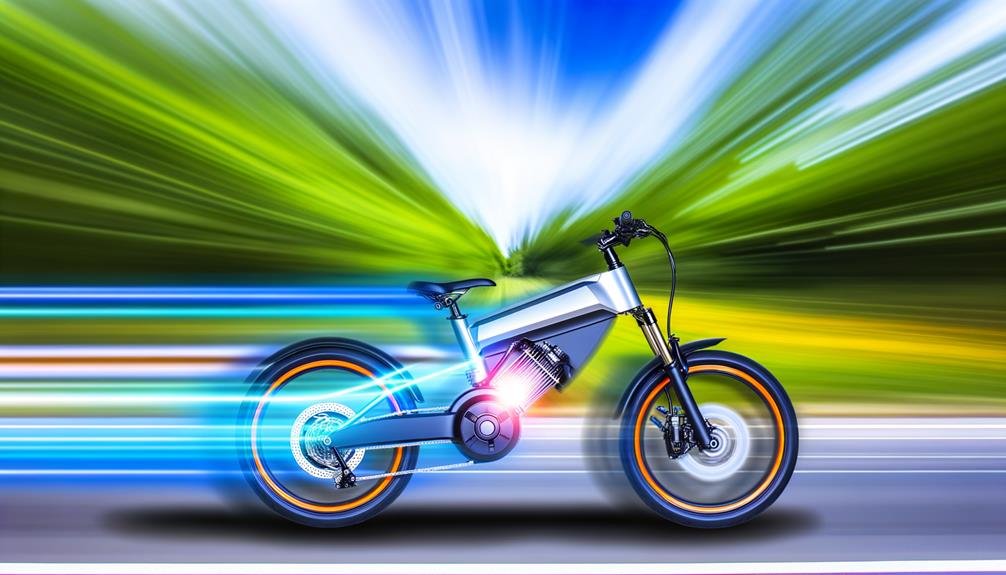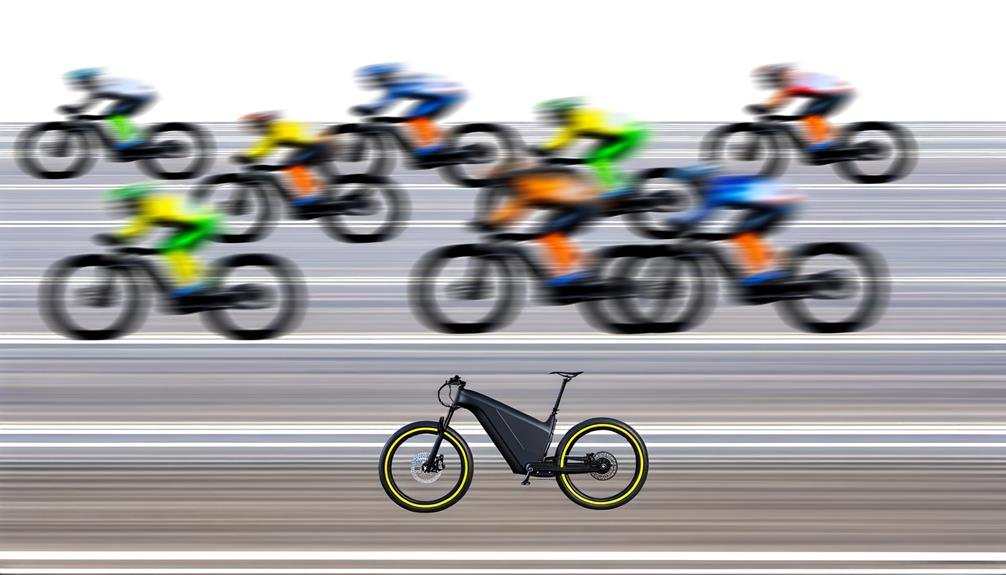Charles Miller is a veteran bike enthusiast with over 12 years of experience dealing with bikes as a mechanic. Despite immense love and expertise for...
Sure, you might think your road bike is fast, but wait until we introduce you to the world of ebikes. We're not talking about those leisurely rides around the park but truly experiencing the thrill of speed that these machines offer.
The top speed of an ebike is a topic of much debate and intrigue, encompassing a range of factors from built-in motor power to regional regulations. But hold onto your helmets, because by the end of this discussion, you'll realize that the question isn't how fast can an ebike go, but rather – how fast do you dare?
Key Takeaways
- Different countries have different speed limits for electric bikes, with the US allowing Class 1 and Class 2 ebikes to reach 20 mph and Class 3 ebikes to reach 28 mph, while the EU and UK limit ebike speeds to 15.5 mph.
- Factors such as the make and manufacturer of the ebike, power output of the motor, battery capacity, and terrain can influence the speed of an ebike.
- Electric motors play a crucial role in determining the top speed of an ebike, with Class 1 and 2 ebikes limited to 20 mph and Class 3 ebikes able to reach up to 28 mph.
- Some ultra-fast ebike models, such as the Hi Power Cycles Revolution XX and Hallomotor FC-1, can exceed conventional speed limits, reaching speeds of 120 km/h and 110 km/h respectively.
Understanding Ebike Speed Limits
When it comes to understanding ebike speed limits, it's crucial to note that different classes of electric bikes have varying speed restrictions depending on the country's regulations. In the US, for instance, Class 1 and Class 2 ebikes are typically limited to a top speed of 20 mph. On the other hand, Class 3 ebikes have a higher maximum speed, allowed to go up to 28 mph.
It's also important to understand that pedal-assist electric bikes stop providing assistance when pedaling above these set ebike speed limits. This means that if you're riding a Class 1 or Class 2 ebike and you exceed 20 mph, you're on your own. If you're on a Class 3 ebike and you go beyond 28 mph, the same rule applies.
However, the speed limits aren't the same globally. In the EU and the UK, regulations are stricter. Here, ebikes are required to provide assistance only when pedaling and typically limit speeds to 15.5 mph.
While some off-road electric bikes have a button to remove the speed limit imposed by regulations, it's worth noting that safety becomes a major concern at higher speeds. The fastest electric bikes can reach speeds of 50 or even 60 mph, but we must tread carefully at these velocities.
Factors Influencing Ebike Speed
Now let's delve into the various factors that can influence an ebike's speed, such as make, manufacturer, power, and battery capacity. These factors influencing ebike speed can dramatically affect your riding experience, and understanding them is key to optimizing your journey.
The make and manufacturer of an ebike can have a substantial impact on its speed. Different brands and models will have varying capabilities due to the design of the e-bike motors, capacity of the battery, and efficiency of the electric system.
The power output of the motor plays a crucial role in determining the speed. Typically, the higher the power output, the faster the ebike can go. However, the power output must be balanced with battery capacity to ensure a reasonable range and longevity of the ride.
The terrain also significantly influences the ebike's speed. Steep inclines can slow the bike down, while declines can allow for speeds exceeding the typical limits. Conversely, flat terrains provide a consistent and predictable speed.
The Role of Electric Motors in Speed

Building on our understanding of various factors affecting ebike speed, let's explore the central role of electric motors in shaping this crucial aspect.
The electric motors determine the top speed of an ebike. Class 1 and 2 ebikes, equipped with motors such as Bosch Performance Line Speed and Shimano Steps E6100, are limited to 20 mph, while Class 3 ebikes can reach up to 28 mph. These are not the fastest electric bikes, however, as certain models can exceed these limits on steep declines due to their mass.
Electric motors not only assist in maintaining a steady speed but also in exceeding the limits defined by the class of the ebike. The pedal-assist function, for instance, stops providing assistance beyond the class-defined speeds.
Below is a table displaying the relationship between ebike classes, their motors, and their top speeds:
| Ebike Class | Electric Motor | Top Speed |
|---|---|---|
| Class 1 | Various | 20 mph |
| Class 2 | Various | 20 mph |
| Class 3 | Bosch Performance Line Speed, Shimano Steps E6100 | 28 mph |
Comparing Ebike Speed to Traditional Bikes
Let's now compare the speed of ebikes to traditional bikes.
When pedaling under optimal conditions, a physically fit cyclist can reach a speed of 20 mph on a traditional bike, a speed that matches the limit of Class 1 and 2 ebikes but falls short of the 28 mph limit of Class 3.
However, factors such as rider fitness, terrain, and wind resistance can significantly affect the speed of a traditional bike.
On the other hand, ebikes have the advantage of electric assistance to maintain consistent speed under varying conditions.
Ebike Versus Traditional Speed
Comparing the speed of e-bikes to traditional bikes, it's clear that the electric versions, particularly Class 3, can offer significantly higher top speeds, given their ability to reach up to 28 mph and even beyond in some exceptional models. When we consider ebike versus traditional speed, the top speed of an ebike often surpasses that of a conventional bike. This is particularly true for riders who may struggle to reach high speeds on traditional bikes due to factors like terrain and fitness level.
However, it's important to note that while e-bikes can reach speeds faster, they're governed by laws and regulations that vary by country. For instance, in the UK, e-bikes can only assist up to 15.5mph.
Factors Influencing Ebike Speed
Having established the impressive top speeds that ebikes can reach compared to traditional bikes, it's equally important to examine the factors that influence these speeds, as they can vary significantly based on several key considerations.
The motor power and battery voltage of the ebike play a pivotal role in determining the top speed of an ebike. A higher voltage and more powerful motor will enable the bike to go faster.
Rider weight also influences the speed an ebike can attain. A lighter rider will generally be able to achieve higher speeds than a heavier one.
The terrain is another major factor. Ebikes will reach their top speeds more easily on flat terrain than on steep inclines or off-road trails.
Fastest Ebike Models on the Market

Turning our attention to the fastest ebike models on the market, we find some truly impressive machines.
The Hi Power Cycles Revolution XX, for instance, tops the list with a staggering speed of 120km/h.
However, the Hallomotor FC-1 and the Nireeka Mega 1500 also hold their own in the high-speed ebike category, with top speeds of 110km/h and 61km/h respectively.
High-Speed Ebike Brands
Diving into the world of high-speed ebikes, we find models like the Hi Power Cycles Revolution XX and the Hallomotor FC-1, which shatter the conventional speed limits set by US classifications, reaching exhilarating speeds of up to 120km/h and 110km/h respectively.
These Fast Electric Bikes are among the fastest Bikes on the Market, not only offering speed, but also:
- Unmatched power for hill climbs
- Robust build for durability
- Advanced tech for smooth rides
These High-Speed Ebike Brands are redefining the boundaries of Speed, making rides Faster and more thrilling.
Be part of this exhilarating journey and experience the thrill of high speeds, all while enjoying the freedom and convenience that these revolutionary ebikes offer.
Ebike Speed Regulations
While most Class 1 and Class 2 ebikes in the US are speed-limited to a modest 20 mph (32 km/h), and Class 3 ebikes cap at 28 mph (45 km/h), there's a new breed of ultra-fast models that defy these standards, boasting top speeds that can even surpass 60 mph.
Ebike speed regulations in the United States, UK, and Europe were crafted with the safety of all road users in mind, but as technology advances, the top speed of an ebike is continually challenged. Legal speed limits are blurred by ebikes like the Hi Power Cycles Revolution XX, that push boundaries with their 120 km/h top speed.
As we navigate this thrilling era, we must balance our desire for speed with safety and legality.
Breaking Ebike Speed World Records
Despite the speed limits set for different classes of ebikes, a handful of daring individuals have shattered these boundaries, pushing the limits of what's possible with electric bikes. These audacious riders aren't just going fast, they're breaking ebike speed world records, and in doing so, redefining how fast electric bikes can go.
In this quest for speed, several noteworthy triumphs stand out:
- Some bikes, defying standard categorization, reach astounding speeds of 50 or even 60 mph, challenging our notions of safety.
- The Hi Power Cycles Revolution XX, a titan among ebikes, boasts an unparalleled top speed of 120 km/h.
- Riders are continually pushing the envelope, testing the very fabric of ebike design and capability.
These feats aren't merely about breaking records or seeing how fast one can go. They're about exploration, innovation, and expanding the boundaries of the ebike community. These daredevils aren't just riders; they're pioneers, leading us into a thrilling, fast-paced future.
Their daring ventures inspire us to reach beyond our comfort zones, to push the limits of speed, and to be a part of the exciting world of fast electric bikes.
Frequently Asked Questions
Can an Electric Bike Go 60 Mph?
We've seen some ebikes hitting 60 mph, but it's not common. Battery longevity, speed control, safety measures, legal implications, and aerodynamic design all factor into this. It's fascinating, yet raises concerns about safety and legality.
Can Electric Bikes Go 30 Mph?
We're navigating speed regulations, battery impact, and uphill performance. Most e-bikes cap around 28 mph, but with aerodynamic designs and rider safety in mind, some can push to 30 mph. It's a thrilling, inclusive ride.
How Fast Can Electric Bikes Go?
We've found that ebike efficiency, speed control, battery impact, terrain influence, and safety measures all factor into how fast they can go. Typically, they reach speeds up to 28 mph, depending on the bike's class.
What Is the Fastest Street Legal Ebike?
We've found that the fastest street legal ebike is the Hi Power Cycles Revolution XX, reaching up to 120 km/h. However, speed regulations, performance factors, battery influence, legal implications, and safety measures must be considered.
Conclusion
In conclusion, we've discovered that ebike speeds depend on numerous factors such as class, motor, and local regulations.
Most intriguingly, the fastest ebike on record clocked a staggering 60 mph, although such speeds aren't legal on public roads.
It's clear that ebikes provide an impressive alternative to traditional bikes, offering an exhilarating blend of speed and efficiency.
Always remember to check your local laws and ride safely!

Charles Miller is a veteran bike enthusiast with over 12 years of experience dealing with bikes as a mechanic. Despite immense love and expertise for his Tacoma, he rides his Trek Ebike more. Anytime you meet him, you’ll either hear him talking about Bikes, or writing about all things bikes and cars on this blog.
More Posts


